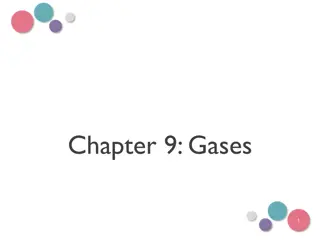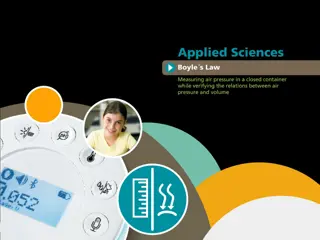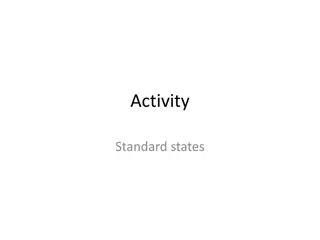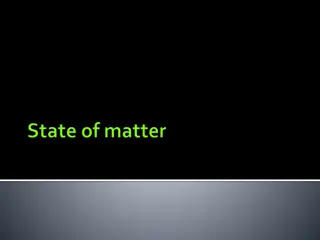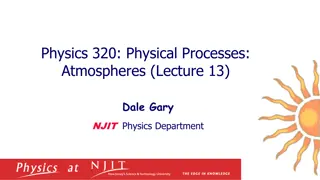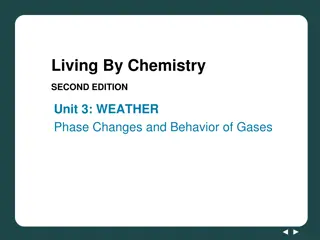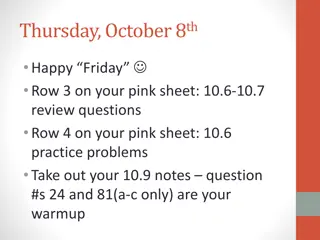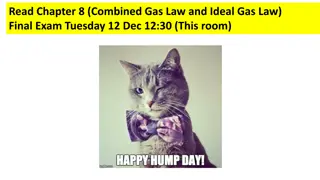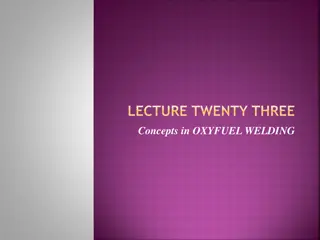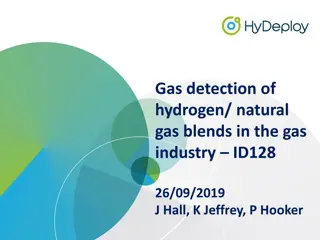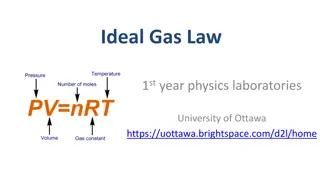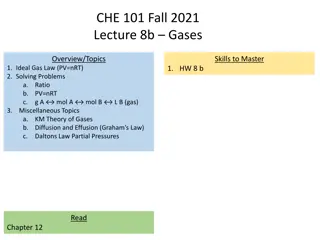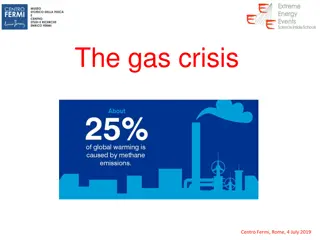Introduction to Ideal Gas Law and Behavior of Gases
Exploring the concepts of the Ideal Gas Law, gas behavior, and the relationship between pressure, temperature, and volume. Learn about the properties of gases, calculations involving gas molecules, moles, Avogadro's number, and the Ideal Gas Law in terms of moles. Discover how to apply these principles through examples and understand the fundamental principles governing the behavior of gases.
Download Presentation

Please find below an Image/Link to download the presentation.
The content on the website is provided AS IS for your information and personal use only. It may not be sold, licensed, or shared on other websites without obtaining consent from the author.If you encounter any issues during the download, it is possible that the publisher has removed the file from their server.
You are allowed to download the files provided on this website for personal or commercial use, subject to the condition that they are used lawfully. All files are the property of their respective owners.
The content on the website is provided AS IS for your information and personal use only. It may not be sold, licensed, or shared on other websites without obtaining consent from the author.
E N D
Presentation Transcript
Introduction to Physical Science The Ideal Gas Law Presented by Robert Wagner
Behavior of Gases Composed of atoms and molecules ?2,?2,??,?? Gases are easily compressed Particles are very spread out relative to their sizes Standard Temperature and Pressure (STP) 0?????1.01?105?? Image Credit: OpenStax College Physics - Figure 13.17 CC BY 4.0
Relation of Pressure, Temperature and Volume Inflating a tire First volume increases Next, pressure increases Increased temperature will give an increase in pressure Ideal Gas Law relates these ?? = ??? ? = 1.38?10 23?/? ; Boltzmann Constant Image Credit: OpenStax College Physics - Figure 13.18 CC BY 4.0
Example Calculate the number of molecules in a cubic meter of gas at STP (Standard temperature and pressure) Draw a sketch Identify known values Identify equation Enter values in the equation and solve Image Credit: PantheraLeo1359531, CC BY 4.0 <https://creativecommons.org/licenses/by/4.0>, via Wikimedia Commons
Example ? = 0??(273?);? = 1.01?105??; ? = 1.00?3;? = 1.38?10 23?/? Calculate the number of molecules in a cubic meter of gas at STP (Standard temperature and pressure) ?? = ??? Draw a sketch ? =?? Identify known values ?? Identify equation ? =(1.01?105??)(1.00?3) (1.38?10 23(273?) Enter values in the equation and solve ? = 2.68?1025????????? Image Credit: PantheraLeo1359531, CC BY 4.0 <https://creativecommons.org/licenses/by/4.0>, via Wikimedia Commons
Moles and Avogadros Number Because the number of molecules is so large, we come up with another unit One mole is defined to be the number of atoms in exactly 12 graphs of carbon- 12 This is known as Avogadro s number (??) ??= 6.02?1023??? 1 For all gases there are 22.5?/??? - see example 13.8 in the textbook for how this is determined.
Ideal Gas Law (moles) The Ideal Gas Law can be restated in terms of moles. ?? = ??? ? = 8.31?/??? ? ? = 1.99???/??? ? ? = 0.821? ???/??? ? Image Credit: OpenStax College Physics - Figure 8.8
Example How many moles of gas are in a bike tire with a volume of 2.00?10 3?3, a pressure of 7.00?105?? at a temperature of 18.0??? Draw a sketch Identify known values Identify equation Enter values in the equation and solve Image Credit: PierreSelim, CC BY 3.0 <https://creativecommons.org/licenses/by/3.0>, via Wikimedia Commons
Example ? = 7.00?105??;? = 2.00?10 3?3 ? = 18.0??(291?);? = 8.31?/??? ? How many moles of gas are in a bike tire with a volume of 2.00?10 3?3, a pressure of 7.00?105?? at a temperature of 18.0??? Draw a sketch ? =?? ?? ? =(7.00?105??)(2.00?10 3?3) (8.31?/??? ?)(291?) Identify known values Identify equation ? = 0.579??? Enter values in the equation and solve Image Credit: PierreSelim, CC BY 3.0 <https://creativecommons.org/licenses/by/3.0>, via Wikimedia Commons
Problem Solving Strategies Determine that an ideal gas is involved List the known values and convert to SI units Determine the unknown Which form of ideal gas law to use? Do you know molecules or moles? Manipulate the equation as needed to solve for unknown Substitute in known values Check to make sure the answer is reasonable
Phase Diagrams Matter can be in the solid, liquid or gas phase A phase diagram plots temperature and pressure Boundaries between phases Critical point - liquid phase no longer exists Triple point - all three phases exist Sublimation - phase change from solid to gas Image Credit: OpenStax College Physics - Figure 13.18 CC BY 4.0
Summary The ideal gas law relates pressure, temperature and volume of an ideal gas Avogadro s number give the number of molecules in a specified quantity of matter A phase diagram shows at which temperatures and pressures the different phases will exist


